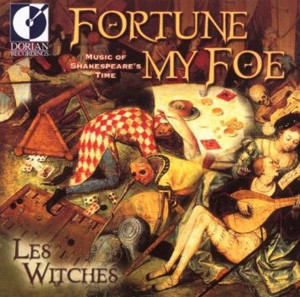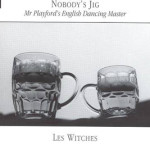Les Witches is an early music ensemble who, according to their Web site, seek to “resurrect the ambience of the bars and taverns of Shakespeare’s time. . . .” They certainly seem to have done that, although when their focus moves to the court music of the seventeenth century, it’s not quite so obvious.
 Fortune My Foe takes its cue from the Decree of 1572, which effectively outlawed in England all musicians and actors who were without patrons. This is perhaps one of the things that sparked the spread of English music on the Continent, as itinerant performers left for more sympathetic situations. This collection presents a range of music by English composers, both in their original renderings (as far as that can be known) and as adapted by Continental composers such as Michael Pretorius and Jacob Van Eyck. There’s somewhat of a surreal quality to this album: quite often the musicians seem to be playing several songs at once, sometimes at cross-purposes, in an attempt, I suppose, to portray the ambience of a sixteenth-century street inhabited by itinerant players.
Fortune My Foe takes its cue from the Decree of 1572, which effectively outlawed in England all musicians and actors who were without patrons. This is perhaps one of the things that sparked the spread of English music on the Continent, as itinerant performers left for more sympathetic situations. This collection presents a range of music by English composers, both in their original renderings (as far as that can be known) and as adapted by Continental composers such as Michael Pretorius and Jacob Van Eyck. There’s somewhat of a surreal quality to this album: quite often the musicians seem to be playing several songs at once, sometimes at cross-purposes, in an attempt, I suppose, to portray the ambience of a sixteenth-century street inhabited by itinerant players.
 The impulse for Bara Faustus’ Dreame, subtitled “Mr. Francis Tregian his choice,” came from a novel by Anne Cuneo, in which Sir Francis travels the Continent, acting as a messenger and sometime spy. (It seems the real Sir Francis was something of a shady character, and not nearly so chivalrous as the fictional version.) The music is marked by more clarity in this collection, since the performers have opted to play one song at a time. The origins of these songs are, once again, a mix of English originals and Continental adaptations. The ensemble is joined here by Guest Witches Nathalie Marec, soprano; Bruno Boterf, tenor; Charles-Edouard Fantin, pandora; Sylvia Abramowicz, treble and tenor viols; and Martin Bauer, bass viol.
The impulse for Bara Faustus’ Dreame, subtitled “Mr. Francis Tregian his choice,” came from a novel by Anne Cuneo, in which Sir Francis travels the Continent, acting as a messenger and sometime spy. (It seems the real Sir Francis was something of a shady character, and not nearly so chivalrous as the fictional version.) The music is marked by more clarity in this collection, since the performers have opted to play one song at a time. The origins of these songs are, once again, a mix of English originals and Continental adaptations. The ensemble is joined here by Guest Witches Nathalie Marec, soprano; Bruno Boterf, tenor; Charles-Edouard Fantin, pandora; Sylvia Abramowicz, treble and tenor viols; and Martin Bauer, bass viol.
 Nobody’s Jig is subtitled “Mr Playford’s English Dancing Master.” That is, in fact, the title of a book of dances, with the tunes for each, published by John Playford beginning in 1651. (The measure of its popularity may be gleaned from the fact that successive editions appeared at more or less regular intervals until 1728.) And this is, indeed, a collection of dances, from the first track, “Nobody’s Jig, Mr. Lane’s Maggott, Black and Grey” through the bonus track, “Pavane dan vers.” The music is by turns lively, stately, and sometimes even pensive. One is struck regularly by the precision and clarity of the playing on such selections as “Bobbing Joe,” which is, oddly, even more apparent in the softer passages than in the more forceful, giving the whole piece a feeling of transparency. It’s a hallmark of this album, and, in fact, Les Witches’ style.
Nobody’s Jig is subtitled “Mr Playford’s English Dancing Master.” That is, in fact, the title of a book of dances, with the tunes for each, published by John Playford beginning in 1651. (The measure of its popularity may be gleaned from the fact that successive editions appeared at more or less regular intervals until 1728.) And this is, indeed, a collection of dances, from the first track, “Nobody’s Jig, Mr. Lane’s Maggott, Black and Grey” through the bonus track, “Pavane dan vers.” The music is by turns lively, stately, and sometimes even pensive. One is struck regularly by the precision and clarity of the playing on such selections as “Bobbing Joe,” which is, oddly, even more apparent in the softer passages than in the more forceful, giving the whole piece a feeling of transparency. It’s a hallmark of this album, and, in fact, Les Witches’ style.
 The selections included in Manuscrit Susanne van Soldt are taken from the keyboard book of a young woman whose Protestant family was in exile in England during the Spanish invasion of Flanders at the end of the sixteenth century. Like most such collections of the time, it includes both sacred and secular music. The thrust of the performances here, according to the comments by Freddy Eichelberger, is to present the music as it might have been heard in the van Soldt home, and it is, in fact, quite intimate in feel. The ensemble is joined on this recording by Guest Witches Mickaël Cozien, bagpipes; Françoise Rivalland, rommelpot and percussion; and Sébastien Wonner, mother virginal and organ.
The selections included in Manuscrit Susanne van Soldt are taken from the keyboard book of a young woman whose Protestant family was in exile in England during the Spanish invasion of Flanders at the end of the sixteenth century. Like most such collections of the time, it includes both sacred and secular music. The thrust of the performances here, according to the comments by Freddy Eichelberger, is to present the music as it might have been heard in the van Soldt home, and it is, in fact, quite intimate in feel. The ensemble is joined on this recording by Guest Witches Mickaël Cozien, bagpipes; Françoise Rivalland, rommelpot and percussion; and Sébastien Wonner, mother virginal and organ.
 Konge af Danmark, subtitled ‘l’Europe musicale à la cour de Christian IV brings us to a rather surprising musical center in early modern Europe: the Court of Christian IV of Denmark, where, among others, John Dowland found refuge (and a very handsome salary). I’m reminded that there was much more cultural interchange in the Europe of the sixteenth and seventeenth centuries than we normally consider: in addition to Dowland, Christian employed a number of English musicians, and sent some Danish players to study in Italy. There were also a number of Danish musicians at the English court: Queen Anne was his sister. The ensemble was able to use the historic organ in the chapel of Frederiksborg Castle for this recording, which lends a whole new palette, providing a firm foundation, but it also sometimes adds a surprising dimension, as in the opening piece by Tobias Hume, “The Duke of Holstones Delight” — there’s almost a surreal touch to a piece that otherwise fairly screams “Renaissance!”
Konge af Danmark, subtitled ‘l’Europe musicale à la cour de Christian IV brings us to a rather surprising musical center in early modern Europe: the Court of Christian IV of Denmark, where, among others, John Dowland found refuge (and a very handsome salary). I’m reminded that there was much more cultural interchange in the Europe of the sixteenth and seventeenth centuries than we normally consider: in addition to Dowland, Christian employed a number of English musicians, and sent some Danish players to study in Italy. There were also a number of Danish musicians at the English court: Queen Anne was his sister. The ensemble was able to use the historic organ in the chapel of Frederiksborg Castle for this recording, which lends a whole new palette, providing a firm foundation, but it also sometimes adds a surprising dimension, as in the opening piece by Tobias Hume, “The Duke of Holstones Delight” — there’s almost a surreal touch to a piece that otherwise fairly screams “Renaissance!”
Les Witches (and please don’t ask me to explain the provenance of that name — I’ve not been able to find a clue) stress that their aim is essentially to enter into the time through its music. Their scholarship is evident from the very informative notes included with each CD, and their intelligence and sensitivity are obvious in the performances themselves. I mentioned clarity and transparency above; add to that a sense of the vibrancy of the time and a willingness to dispense, when appropriate, with the reverence that so many performers bring to early music — after all, in Shakespeare’s time, there wasn’t quite the difference between entertainment and “high art” that we try to impose now.
So for those whose tastes run to the music of the Northern Renaissance, I think this group looks pretty much ideal.
(Dorian, 1996)
(Alpha, 2004)
(Alpha, 2008)
(Alpha, 2008)
(Alpha, 2010)
Les Witches is Odilon Edouard, Claire Michon, Silvie Moquet, Pascale Boquet, and Freddy Eichelberger. The specific instruments each plays tend to change from recording to recording.
